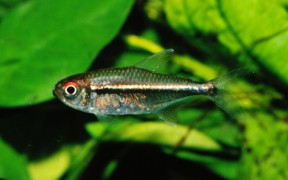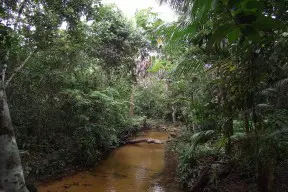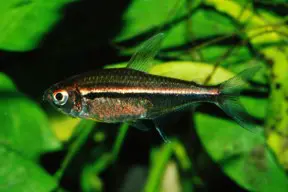Hyphessobrycon heterorhabdus
Flag Tetra
SynonymsTop ↑
Tetragonopterus heterorhabdus Ulrey, 1894
Etymology
Hyphessobrycon: from the Ancient Greek υπελάσσων (hyphesson), meaning ‘of lesser stature’, used as a prefix in this case, plus the generic name Brycon.
heterorhabdus: from the Ancient Greek ἕτερος (héteros), meaning ‘other, different’, and ῥάβδος (rhábdos), meaning ‘rod, wand’. Not explained but possibly in reference to the dark lateral stripe on the body, the main character used by the author to distinguish it from Tetragonopterus (currently Hemigrammus) schmardae, with which it was considered closely related at the time.
Classification
Order: Characiformes Family: Characidae
Distribution
Has been considered to range throughout the lower and middle Amazon basins as far as southern Colombia, but may be restricted to tributaries and coastal drainages in the eastern states of Pará and Maranhão, with the rio Tapajós representing its upstream limit (see ‘Notes’).
The majority of records pertain to localities south and west of Belém, including the rios Guamá, Acará, Tocantins, and Xingu, plus some smaller river systems which drain directly into the Atlantic Ocean, such as the rios Marapanim, Caripi, Maracanã, Caeté, Gurupi, and Pindaré. It has also been collected from various localities within the rio Tapajós, between its confluence with the Amazon and Jacareacanga in the middle part of the basin.
It is not included in recent checklists of Colombian ichthyofauna (e.g. Maldonado-Ocampo et al., 2008), while records from Suriname refer to other taxa (Mol, 2012).
Type locality is ‘Pará, Brazil’.
Habitat
Almost exclusively collected from small streams known as igarapés in the Amazon region, and appears to be a typical resident of terra firme (not subject to long-term annual flooding) headwater tributaries east of the rio Tocantins.
Such habitats are typically shaded by forest cover or riparian vegetation and contain clear water with substrates of sand or mud and submerged tree roots, fallen branches, and leaf litter. Aquatic vegetation is not usually present.
Maximum Standard Length
30 – 35 mm.
Aquarium SizeTop ↑
An aquarium with base dimensions of 80 ∗ 30 cm or equivalent should be the smallest considered.
Maintenance
Perhaps looks best in an arrangement comprising a sandy substrate plus some driftwood roots and branches, or heavily-planted planted set-up.
The addition of dried leaf litter would further emphasise the natural feel and as well as offering additional cover for the fish brings with it the growth of microbe colonies as decomposition occurs.
The latter are useful since they provide an additional food source for both adults and fry while the humic substances released by decaying leaves are also considered beneficial.
Water Conditions
Temperature: 20 – 26 °C
pH: 5.5 – 7.5
Hardness: 18 – 215 ppm
Diet
Likely to be omnivorous feeding on small invertebrates, crustacea, filamentous algae, fallen fruit and suchlike in nature.
In aquaria it may survive on a diet of dried foods but like most fishes does best when offered a varied menu which in this case should also contain live and frozen chironomid larvae (bloodworm), mosquito larvae, Daphnia, Moina, etc.
Behaviour and CompatibilityTop ↑
Very peaceful making it an ideal resident of the well-researched community aquarium.
It is best-maintained alongside similarly-sized characids, gasteropelecids, lebiasinids, smaller callichthyid or loricariid catfishes and non-predatory, small-to-medium-sized cichlids.
Try to buy a mixed-sex group of at least 8-10 specimens, include other schooling fishes to provide security, and you’ll be rewarded with a more natural-looking spectacle.
Sexual Dimorphism
Sexually mature females are noticeably deeper-bodied and a little larger than males.
Reproduction
An egg-scattering free spawner exhibiting no parental care.
When in good condition adults will spawn often and in a mature aquarium it is possible that small numbers of fry may start to appear without intervention, but if you want to maximise yield a more controlled approach is required.
The adult group can still be conditioned together but a smaller aquarium should also be set up and filled with mature water. This should be very dimly lit and the base covered with some kind of mesh of a large enough grade so that the eggs can fall through but small enough so that the adults cannot reach them. The widely available plastic ‘grass’-type matting can also be used and works well, as does a layer of glass marbles. Alternatively, filling much of the tank with a fine-leaved plant such as Taxiphyllum spp. or spawning mops can also return decent results.
The water itself should be of slightly acidic to neutral pH with a temperature towards the upper end of the range suggested above. An air-powered sponge filter or air stone(s) should also be included to provide oxygenation and water movement.
When the adult fish are well-conditioned a single pair or group comprising one or two males and several females can then be introduced to each container and left in place until eggs are detected (typically the following morning).
Initial food should be Paramecium or a proprietary dry food of sufficiently small (5-50 micron) grade, introducing Artemia nauplii, microworm, etc., once the fry are large enough to accept them.
NotesTop ↑
This species is also known as ‘Belgian flag tetra’ in the aquarium hobby.
Its name appears to have been misapplied to similar-looking fishes occurring throughout much of the middle and lower Amazon in Brazil and Colombia, the rio Orinoco drainage in Colombia and Venezuela, and coastal systems of the Guianas. Some of these populations have been described as distinct species (e.g. Hyphessobrycon amapaensis Zarske & Géry 1998; H. eschwartzae García-Alzate, Román-Valencia & Ortega 2013; H. montagi Lima, Couthino & Woziacki 2014), whereas the identity of others remains unclear (e.g. H. sp. ‘blackstripe’ from Suriname, H. cf. heterorhabdus from Venezuela).
H. heterorhabdus differs from all of these in some aspects of meristics and morphology, but may be distinguished from the three described species by colour pattern. The dark lateral body stripe is continuous between humeral spot and caudal peduncle (vs. reduced or absent towards caudal peduncle in H. amapaensis), there are no yellow to orange markings in the fins (vs. such markings present in H. eschwartzae), and it possesses only a single humeral spot (vs. two distinct humeral spots in H. montagi).
H. heterorhabdus lends its name to the putative ‘H. heterorhabdus-group’ of closely-related species within the genus as proposed by Géry (1977). This originally comprised around 15 members characterised by a ‘longitudinal pattern’ consisting of a thin, usually dark, lateral body stripe, but has since been modified on a number of occasions.
Most recently, Lima et al. (2014) proposed a putatively monophyletic H. heterorhabdus-group containing only three species; Hyphessobrycon heterorhabdus, H. amapaensis, and H. eschwartzae. These all possess: a well-defined, elongate humeral blotch which is continuous with a dark, well-defined midlateral stripe that becomes blurred towards the caudal peduncle; a longitudinal red stripe extending along the body above the midlateral line; upper half of the eye red.
This pattern is different to that presented by several members of Géry’s H. heterorhabdus group, such as H. vilmae, H. cachimbensis, and H. stegemanni, which possess a continuous, solid dark lateral stripe on the body and no obvious humeral blotch, but is similar to that of Géry’s H. agulha group. The latter contained species with a colour pattern comprising “lower half of the body dark, especially above anal fin; usually a horizontally elongate humeral spot, more or less united with the assymetrical, broad band”, and included H. agulha, H. loretoensis, H. peruvianus, H. metae, and H. herbertaxelrodi.
Hyphessobrycon was raised by Durbin in Eigenmann (1908) as a subgenus of Hemigrammus, differing from the latter by the absence of scales on the caudal-fin.
The grouping was revised by Eigenmann (1918, 1921) while Géry (1977) created artificial groups of species based on colour pattern, and these definitions are still widely used today, e.g., the H. agulha group, the H. heterohabdus group, etc. These cannot be considered to represent monophyletic assemblages, however, and their concepts continue to be redefined.
Weitzman & Palmer (1997) hypothesised the existence of a monophyletic assemblage within the genus based on colour pattern and male fin morphology that they termed the ‘rosy tetra clade’, with one of the characters supporting its monophyly being presence of a prominent dark marking on the dorsal-fin. This assemblage, plus other morphologically similar species, is considered to represent Hyphessobrycon sensu stricto by some authors, with the remaining species included in a much-expanded H. heterohabdus group.
Others have proposed conflicting, typically more restricted, views of both the genus and/or its constituent species groups, and significant confusion remains. What is clear is that, as currently recognised, Hyphessobrycon is a polyphyletic lineage containing several genera.
The process of splitting it up has already started, and Malabarba et al. (2012) revalidated the genus Ectrepopterus Fowler, previously considered a synonym of Hyphessobrycon. They also analysed its relationships within the Characidae in the context of Mirande’s (2010) previous work, but included the type species, H. compressus, for the first time in such a study. The results demonstrated that H. compressus is more closely-related to ‘rosy tetra’ representatives such as H. eques, H. pulchripinnis, and H. socolofi than other members of the genus including H. anisitsi, H. bifasciatus, H. elachys, H. herbertaxelrodi, and H. luetkeni.
References
- Ulrey, A. B., 1894 - American Naturalist 28(331): 610-611
Preliminary descriptions of some new South American Characinidae. - Calcagnotto, D., S. A. Schaefer, and R. DeSalle, 2005 - Molecular Phylogenetics and Evolution 36(1): 135-153
Relationships among characiform fishes inferred from analysis of nuclear and mitochondrial gene sequences. - García-Alzate, C. A., C. Román-Valencia and H. Ortega , 2013 - Revista de Biologia Tropical 61(2): 859-873
Hyphessobrycon taphorni y H. eschwartzae (Teleostei: Characidae) dos nuevas especies de peces de la cuenca del río Madre de Dios, Perú. - Géry, J., 1977 - T. F. H. Publications, Inc.: 1-672
Characoids of the world. - Lima, F. C. T., D. P. Coutinho and W. B. Wosiacki, 2014 - Zootaxa 3872(2): 167-179
A new Hyphessobrycon (Ostariophysi: Characiformes: Characidae) from the middle Amazon basin, Brazil. - Malabarba, L. R., V. A. Bertaco, F. R. Carvalho & T. O. Litz., 2012 - Zootaxa 3204: 47-60
Revalidation of the genus Ectrepopterus Fowler (Teleostei: Characiformes), with the redescription of its type species, E. uruguayensis. - Marinho, M. M. F., F. C. P. Dagosta and J. L. O. Birindelli, 2014 - Neotropical Ichthyology 12(2): 257-264
Hemigrammus ataktos: a new species from the rio Tocantins basin, central Brazil (Characiformes: Characidae). - Mirande, J. M., 2010 - Neotropical Ichthyology 8(3): 385-568
Phylogeny of the family Characidae (Teleostei: Characiformes): from characters to taxonomy. - Mol, J. H. A., 2012 - Brill Academic Publishers: 1-890
The Freshwater Fishes of Suriname. - Oliveira, C. A., G. S. Avellino, K. T. Abe, T. C. Mariguela, R. C. Benine, G. Orti, R. P. Vari, and R. M. Corrêa e Castro, 2011 - BMC Evolutionary Biology 11(1): 275-300
Phylogenetic relationships within the speciose family Characidae (Teleostei: Ostariophysi: Characiformes) based on multilocus analysis and extensive ingroup sampling. - Reis, R. E., S. O. Kullander and C. J. Ferraris, Jr. (eds), 2003 - EDIPUCRS, Porto Alegre: i-xi + 1-729
Check list of the freshwater fishes of South and Central America. CLOFFSCA. - Weitzman, S. H. and L. Palmer, 1997 - Ichthyological Exploration of Freshwaters 7(3): 209-242
A new species of Hyphessobrycon (Teleostei: Characidae) from the Neblina region of Venezuela and Brazil, with comments on the putative `rosy tetra clade'. - Zarske, A., 2014 - Vertebrate Zoology 64(2): 139-167
Zur Systematik einiger Blutsalmler oder "Rosy Tetras" (Teleostei: Ostariophysi: Characidae). - Zarske, A. and J. Géry, 1998 - Zoologische Abhandlungen; Staatliches Museum für Tierkunde in Dresden 50(1): 19-26
Hyphessobrycon amapaensis spec. nov., eine neue und mutmassliche Stellvertreterart von Hyphessobrycon heterorhabdus (Ulrey, 1894) aus dem Bundesstaat Amapa in Brasilien (Teleostei: Characiformes: Characidae).




